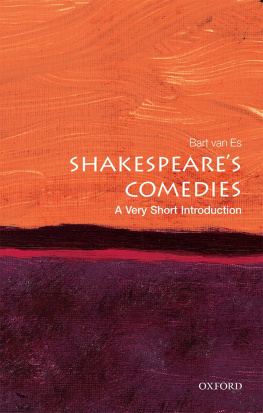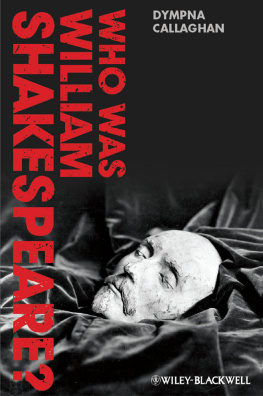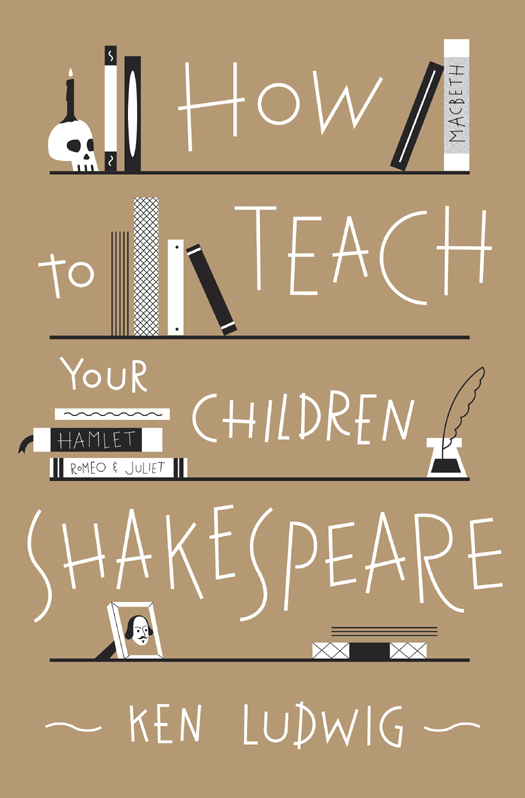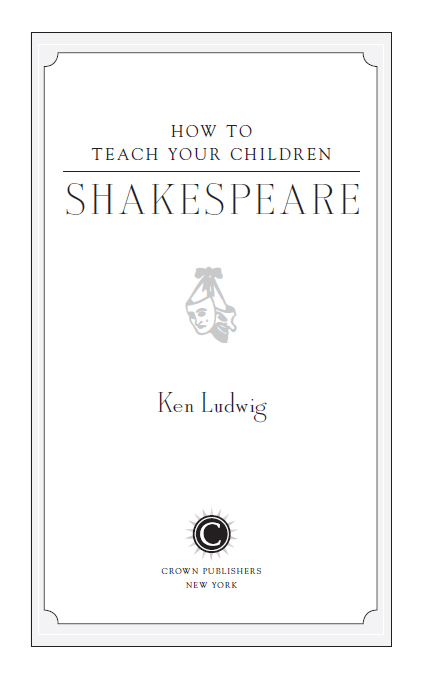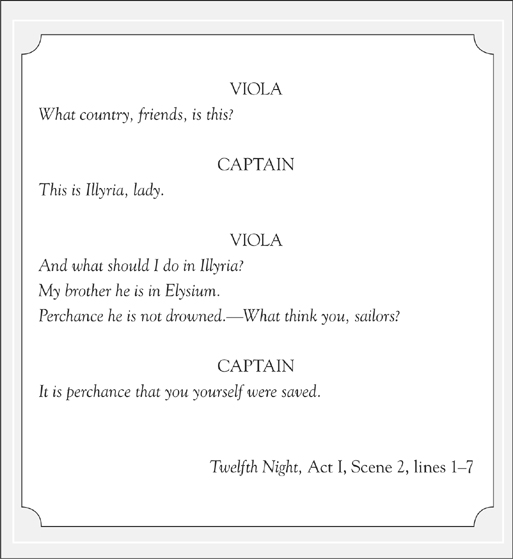HOW TO TEACH YOUR CHILDREN SHAKESPEARE
Copyright 2013 by Ken Ludwig
Introduction Copyright 2013 by John Lithgow
All rights reserved.
Published in the United States by Crown Publishers, an imprint of the Crown Publishing Group, a division of Random House, Inc., New York.
www.crownpublishing.com
CROWN and the Crown colophon are registered trademarks of Random House, Inc.
Library of Congress Cataloging-in-Publication data is available upon request.
eBook ISBN: 978-0-307-95151-9
Hardcover ISBN: 978-0-307-95149-6
Photo credits appear on as an extension of the copyright page.
Book design by Jennifer Daddio/Bookmark Design & Media Inc.
Jacket design by Christopher Brand
v3.1_r1
THIS BOOK IS DEDICATED TO MY CHILDREN,
Olivia and Jack Ludwig,
WHO INSPIRED IT.
IT IS ALSO DEDICATED TO
Barbara Mowat,
GREAT SHAKESPEAREAN, FOR HER FRIENDSHIP AND ADVICE.
A NOTE ON TEACHING
Please bear in mind that this book is intended for teachers of all kinds, not just parents. I developed the techniques in this book by teaching Shakespeare to my children, hence the title of the book. But as I can attest from the teaching Ive done over the years at various schools and universities, these techniques work just as well in the classroom as they do in the living room.
A NOTE ON THE TEXT
The quotations and line numberings in this book are based on the Folger Shakespeare Library edition of Shakespeares plays, edited by Barbara A. Mowat and Paul Werstine. Editions of Shakespeare differ from each other in a number of respects. First, editors must choose which underlying printings of the plays to use as their source material. Second, editors edit their source material for punctuation, spelling, missing words, etc., bringing to bear their wealth of scholarship, endeavoring to present the most accurate text possible to the reader. Finally, editors provide secondary materials to enhance the text, such as definitions of words, explanatory notes, and accompanying essays. There are many fine editions of Shakespeares plays on the market, each with its own advantages and level of detail, but I personally prefer the Folger Shakespeare Library edition for scholarship, ease of use, clarity, and price. Also, I urge readers of this book, when they want to consult one of the plays, to use individual copiesone play per bookand not a Complete Works as are often used in colleges. Those can be difficult to read and difficult to handle physically, which can be off-putting, especially for children.
Contents
A Midsummer Nights Dream
Twelfth Night
Romeo and Juliet
Interlude
Macbeth
Henry IV, Part 1
As You Like It
Henry V
Interlude
Hamlet
The Tempest
Introduction
By John Lithgow
W hen it came to Shakespeare, I was a lucky boy. My childhood was full of Shakespeare. My father, you see, was an itinerant regional theater producer. He ran four outdoor summer Shakespeare festivals out in Ohio when I was a kid. In the decade of the 1950s alone, he presented every single one of the Bards plays, many of them more than once. I knew Shakespearean characters the way my schoolmates knew big league ballplayers: Trinculo, Charmian, Hotspur, Osric, Celia, Benvolio, Froth.
My three siblings and I spent our summers hanging around rehearsals and precociously befriending the actors. When we reached our teens, we provided my father with cheap labor. We built props, stitched costumes, operated light boards, ran concession stands, and mopped the stage. And the background music of our lives in those days was the sound of Shakespearean verse, spoken out loud.
Best of all, we got to play the parts of various children in the plays. My brother was a servant in Julius Caesar . My sister was a murdered prince in Richard III . And in one of the happiest moments of my boyhood, I was cast as Mustardseed, one of the fairies waiting on Titania, in A Midsummer Nights Dream . This meant that I got to prance around onstage night after night, a seven-year-old in a leotard, fairy wings, and pointy yellow fake fur hat, lit up by silvery stage lights and bathed in Shakespeares gorgeous language.
For me the highlight of every performance was the first encounter between Oberon and Titania, the estranged king and queen of the Fairies. In this scene, the two carry on an angry marital squabble, all of it expressed in exquisitely poetic phrases and images. It is as if, when he wrote their dialogue, Shakespeare had been intoxicated by the heady pleasure of writing for fairy royalty. To be honest, at seven years old I had no idea what the couple was fighting aboutwho knew that the argument was an ugly Elizabethan custody dispute? But every night I was dizzy with the beauty of their glorious speeches.
My favorite involved a young woman who had served Titania, a mortal who had died in childbirth, whose child the Fairy Queen had raised as her own son. The speech begins:
His mother was a votress of my order
And in the spiced Indian air by night ,
Full often hath she gossiped by my side
Each night I sat onstage in the spiced air of Yellow Springs, Ohio, and memorized a few more words.
So imagine my delight when, halfway through this marvelous book, I came upon a page that was entirely devoted to this very passage and read Ken Ludwigs description of it as one of the most beautiful speeches in all of Shakespeare. That was the moment when I knew that Ludwig and I, to an uncanny degree, had Shakespeare in common.
Ken Ludwig is not a scholar by profession. He is a playwright and a man of the theater. To him, Shakespeare is primarily a storyteller, an entertainer, and the ultimate authority on the craft of playwriting. Hence, Ludwigs approach to the plays is more passionate than academic. His enthusiasm bubbles over on every page of his book and makes you want to track down whatever Shakespeare play is being performed nearby and rush off to see it.
Ludwig is also a father. He discovered early on that his love of Shakespeare was something that he could share with his children. In hours of reading and reciting with them, he learned a surprising truth: that children are ready, willing, and able to master these four-hundred-year-old plays. Give them the opportunity and they will hungrily devour them. Children, after all, are like sponges. Their young minds are in a constant state of verbal absorption. They are far better students of language than we adults are. Every day they are digesting scores of new words and phrases. What better time to feed them a rich diet of Shakespeares poetry and prose?
This book is a teaching primer for parents and a manual for making Shakespeare manageable and fun for kids. On these terms alone, it succeeds splendidly. But it has an extraordinary hidden virtue. It is equally informative, readable, and fun for adults . It is essential reading for anyone who has grown to adulthood with the misfortune of missing out on Shakespeare. And it is just as rich for those of us with a long history with the Bard. Shakespeares mind is so limitless and Ludwig is so knowledgeable that we discover little gems on every page. And for parents, making such discoveries in the company of their children is especially precious.




